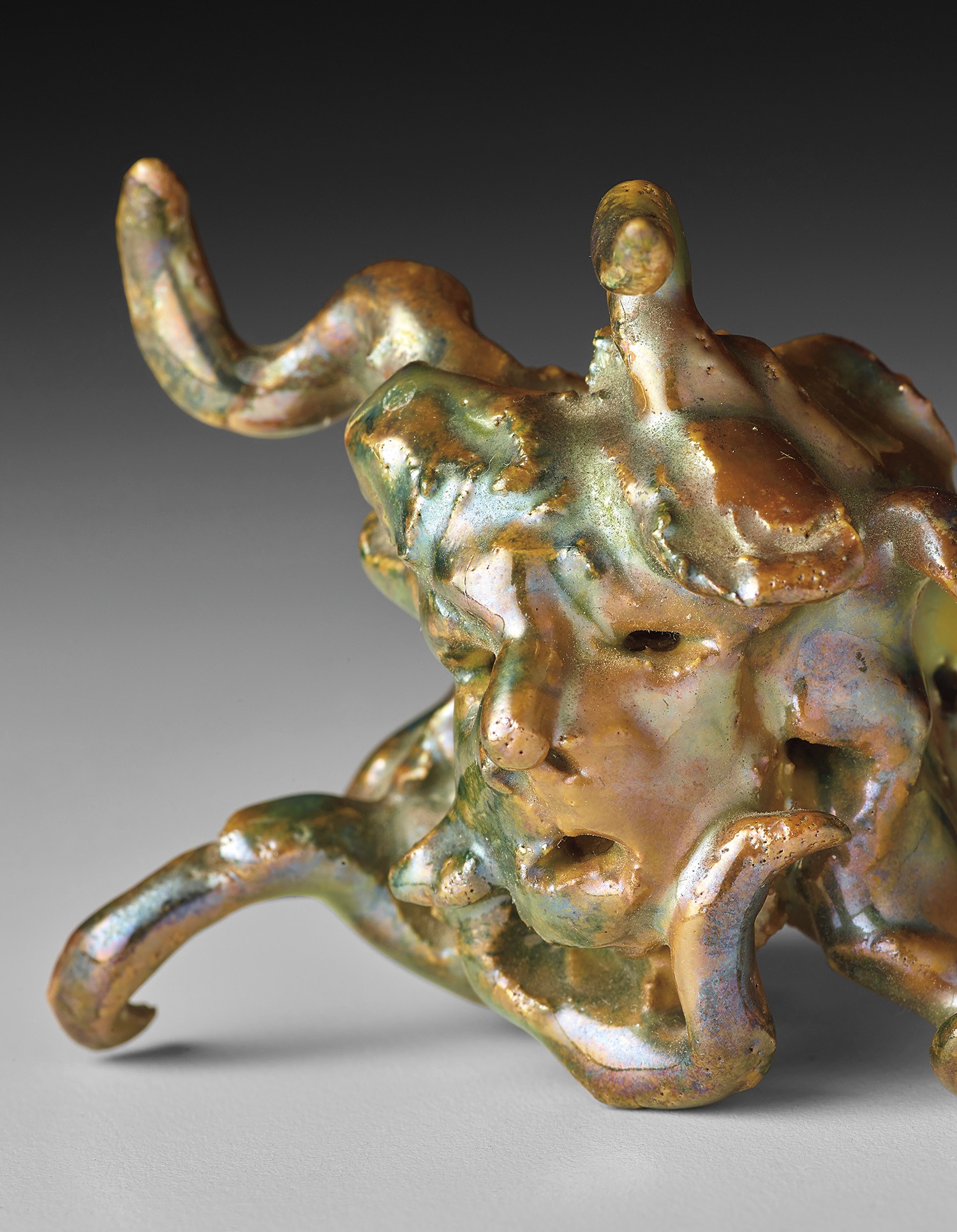



59
Lucio Fontana
Testa di Medusa
incised with the artist's initials 'LF' on the reverse
earthenware, lustre glaze
5.8 x 6 x 4.5 cm (2 1/4 x 2 3/8 x 1 3/4 in.)
Executed in 1947-50, this work is registered with the Fondazione Lucio Fontana under archive no. 1173/001.
Full-Cataloguing
The image of the mythological gorgon figure, Medusa, has been continually revisited throughout art history by artists and artisans alike, inspiring painters and sculptors such as Gian Lorenzo Bernini, Michelangelo Merisi da Caravaggio, Damien Hirst and Lucio Fontana. Traditionally symbolic of unbridled terror, violence and fear, in Lucio Fontana’s Testa di Medusa, the visage of the gorgon, with her piercing eyes, is frozen in clay, subverting the mythology of Medusa’s deadly glare, which, with a single glance, can transfigure your body into stone.
In the 1930s, Fontana travelled to Albissola and the Mazzotti factory, where he started work on his practice, later returning in the 1940s to continue incorporating his Spazialismo ethos within the medium of clay. Having trained in sculpture and ceramics, Fontana had spent his formative years in his father's studio in Rosario de Santa Fe, Argentina, making religious icons for funerals, such as Christ figures and the Virgin and Child. Working with clay provided Fontana with a reactive and flexible medium, malleable properties which bore a symbiosis with Fontana’s Concetto spaziale. Slashing, tearing, rupturing or penetrating his medium with Murano glass, Fontana looked to marry light, sound and form in his holistic works, creating a new visual dialogue with multidimensionality at the forefront of his enquiry. Evident in the neon tendrils of his pinnacle installation Ambiente spaziale a luce nera, 1949, exhibited at the Galleria del Naviglio in Milan, the deep gouges in his monumental terracotta Natura and the opalescent blend of multi-coloured glazes which dance on the surface of his Crocifissione, Fontana’s practice prises open the possibilities of representation. Caught in a fleeting moment between abstraction and figuration, Fontana’s Testa di Medusa showcases the qualities of his chosen medium and celebrates the movement of the clay in its plasticity. Commenting on Fontana’s deft ability to harness the material properties of clay when handling the medium, art critic and friend Guido Balla noted, ‘his hands created an aerial musicality and he remained silent as though in a trance’ (Guido Balla, quoted in, Valérie Da Costa, Lucio Fontana, Deposizione della Croce, Galerie Karsten Greve, Paris, 2017, online).
In the 1930s, Fontana travelled to Albissola and the Mazzotti factory, where he started work on his practice, later returning in the 1940s to continue incorporating his Spazialismo ethos within the medium of clay. Having trained in sculpture and ceramics, Fontana had spent his formative years in his father's studio in Rosario de Santa Fe, Argentina, making religious icons for funerals, such as Christ figures and the Virgin and Child. Working with clay provided Fontana with a reactive and flexible medium, malleable properties which bore a symbiosis with Fontana’s Concetto spaziale. Slashing, tearing, rupturing or penetrating his medium with Murano glass, Fontana looked to marry light, sound and form in his holistic works, creating a new visual dialogue with multidimensionality at the forefront of his enquiry. Evident in the neon tendrils of his pinnacle installation Ambiente spaziale a luce nera, 1949, exhibited at the Galleria del Naviglio in Milan, the deep gouges in his monumental terracotta Natura and the opalescent blend of multi-coloured glazes which dance on the surface of his Crocifissione, Fontana’s practice prises open the possibilities of representation. Caught in a fleeting moment between abstraction and figuration, Fontana’s Testa di Medusa showcases the qualities of his chosen medium and celebrates the movement of the clay in its plasticity. Commenting on Fontana’s deft ability to harness the material properties of clay when handling the medium, art critic and friend Guido Balla noted, ‘his hands created an aerial musicality and he remained silent as though in a trance’ (Guido Balla, quoted in, Valérie Da Costa, Lucio Fontana, Deposizione della Croce, Galerie Karsten Greve, Paris, 2017, online).